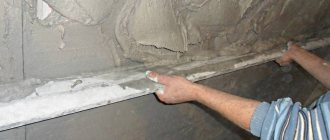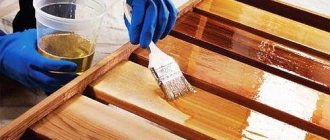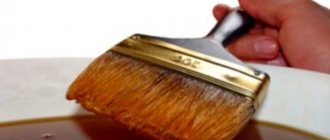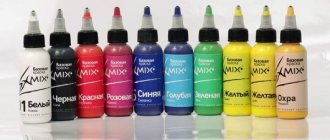What is drying oil
A film-forming agent, which is produced in accordance with GOST 7931-76 on the basis of such natural oils as:
- rapeseed;
- soy;
- linen;
- sunflower;
- hemp.
It is a clear liquid that can smell or stink pleasantly, and is sometimes dark red in color.
Cobalt, manganese, and lead siccatives are also added to the composition, accelerating hardening.
Specifications:
- Drying time is a day.
- Drying temperature – 23°C.
- Giving a golden glossy hue to the treated surface.
Technical characteristics of natural drying oil.
Advantages and disadvantages
Like any product, drying oil has advantages and disadvantages.
In the list of advantages:
- The ability to protect wooden surfaces from destruction and exposure to parasites;
- Creating a base for paint;
- Possibility of imparting a certain shade to the treated surface;
- Versatility and ease of use.
Flaws:
- The ability to burn out, which necessitates re-treatment of surfaces;
- Specific odor and toxicity of synthetic drying oil and oxol;
- The need to apply some compounds more than once to achieve a good result;
- The ability to ignite due to the presence of highly flammable elements in the composition.
All of the above disadvantages are usually inherent in cheap, low-quality products.
The ability to protect wooden surfaces from destruction and exposure to parasites.
Historical facts
Several centuries ago, amber and other resins were added to natural oil. The resulting composition was used to treat wood to protect it from moisture. It was also used by artists in the design of paintings, icons and plaster products. With the development of the chemical industry and the development of other protective agents, many industries abandoned drying oil (especially its use in apartments), because as new paintwork materials had high quality indicators and low cost. Now it is used for finishing wooden products and impregnation before painting.
Semi-natural drying oils
Representatives of this species also received their second name “oxol”; technologically they are also made from oils, but subjected to oxidation, with the addition of solvents and driers. In this case, the percentage of oil is 55%, the solvent (white spirit is most often used) is at least 40%. Due to this composition, the liquid has a rather unpleasant and pungent odor, which can persist for some time even after drying.
In terms of cost, oxol is much more economically profitable than natural, but at the same time it has practically no differences in basic properties and is almost identical in appearance.
The most valued is oxol made from flax oil - the film of such a product is hard, elastic, water resistant and, notably, has the greatest durability.
To reduce the cost even further, it is also produced from sunflower oil, but its film characteristics are significantly lower than those made from flax oil.
Operating principle
Once applied to wood, the product saturates it and fills the pores. The oil then dries and prevents water from penetrating into the material.
As a result, bacteria do not infect the product and it does not deteriorate.
In open air, the oil thickens due to the presence of acids in it. Drying oil applied in a thin layer dries to form a durable film. To speed up the hardening process, vegetable oils are subjected to heat treatment and driers are added to them.
Compositions without metal compounds are used less frequently. Their drying speed is 5 days, which allows the oil component to penetrate deep into the wood, thereby increasing its moisture resistance and ability to resist fungus and insects.
Natural drying oil
According to GOST, the product in question must consist of at least 97% natural vegetable oil (drying or semi-drying, as well as mixtures thereof, mainly flax oil, occasionally sunflower, soybean, hemp oil).
During production, oils are exposed to prolonged exposure to high temperatures (at least 300°C) for 12 hours; the next step is the use of air blowing.
As a result, we get an oily, opaque, thick liquid consistency of a rich brown and sometimes greenish color with a slight smell of the base oil.
Drying oil based on flax oil looks like a light-colored liquid, transparent and oily.
Its main purpose is to perform the following tasks:
- primer of various surfaces: wood, metal or previously plastered;
- manufacturing and obtaining the required consistency of thickly rubbed paint in light colors, putty, paste for lubrication;
- as a light-colored painting composition used indoors and outdoors for painting metal structures, window and door openings, and flooring.
It will take no more than a day to dry completely at room temperature.
Drying oil from hemp oil is dark in appearance and due to this it is mainly in demand, just like drying oil from flax oil, but when it is required to obtain dark tones. It dries similarly in no more than a day.
Drying oil made from sunflower oil dries much worse and will require much more time than a day to dry completely. In addition, although the film turns out to be quite elastic, it is inferior to the drying oils discussed above in such indicators as:
- hardness;
- strength;
- water resistance.
Table 1. Indicators of oil drying oils.
| Indicator name | Meaning for drying oils | Test method | |||
| natural | oxol | combined | |||
| linen | hemp | ||||
| 1 Color on the iodometric scale, mg I2 /100 cm3, not darker | 400 | 1600 | 800 | 800 | According to GOST 19266 and 9.3 of this standard |
| 2 Sludge, % (by volume), no more | 1 | 1 | 1 | 1 | According to GOST 5481 |
| 3 Conditional viscosity according to a VZ-246 type viscometer with a nozzle diameter of 4 mm at a temperature of (20 ± 0.5) °C, s | 26-32 | 26-32 | 18-25 | 20-60 | According to GOST 8420 |
| 4 Acid number, mg KOH, no more | 6 | 7 | 8 | 10 | According to GOST 5476 |
| 5 Transparency after standing for 24 hours at a temperature of (20 ± 2) °C | Full | Full | Full | Full | According to GOST 5472 |
| 6 Drying time to degree 3 at temperature (20 ± 2) °C, h, no more | 24 | 24 | 24 | 24 | According to GOST 19007 |
| 7 Mass fraction of non-volatile substances, % | — | — | 54,5-55,5 | 70 ±2 | According to GOST 17537 and 9.9 of this standard |
| 8 Flash point in a closed crucible, °C, not less | — | — | 32 | 32 | GOST 9287 |
| 9 Density at temperature (20 ± 2) °C, g/cm3 | 0,936-0,950 | 0,930-0,940 | — | — | According to GOST 18995.1 |
| 10 Iodine number, mg iodine per 100 g, not less | 155 | 150 | — | — | According to GOST 5475, section 2 |
| 11 Mass fraction of phosphorus-containing substances in terms of P2 O5, %, no more | 0,026 | 0,026 | — | — | According to GOST 7824, section 2 and 9.13 of this standard |
| 12 Mass fraction of unsaponifiable substances, %, no more | 1 | 1 | — | According to GOST 5479 | |
| 13 Mass fraction of ash, %, no more | 0,3 | 0,3 | — | — | According to GOST 5474 and 9.15 of this standard |
| 14 Resin acids | Absence | — | — | By 9.16 | |
| Note - It is allowed to use oxol-type drying oil with other indicators of the mass fraction of non-volatile substances and conditional viscosity, provided that this brand of drying oil meets all the standard requirements for this group of drying oils. | |||||
Areas of application
The main purpose of the product is wood processing. It is also used in the production of paints, finishing agents, putties and primers.
Drying oil can be used for processing wooden structures.
Area of use:
- Processing of wooden elements of houses (windows, doors, floors, stairs, railings).
- Priming surfaces before painting.
- Making hives.
- Shipbuilding.
- Furniture repair.
- Thinning paints and varnishes.
Paint production
To improve the quality of coloring elements, it is necessary to add binders to them. Due to this, the mass will lie flat and will not crumble.
Compositions diluted with drying oil are of high quality, form a hard coating, and can be used for interior work, because do not emit toxic substances.
Surface treatment
Wood is widely used in construction and finishing, but due to its low durability it must be treated to protect it from damage. Drying oil helps reduce paint consumption. It is also used to prime plastered and metal surfaces to prevent corrosion.
Application area
Drying oil is used in finishing matters. At the same time, it is used to color wood. It is worth considering that drying oil is very different from varnish. Firstly, it is a film that forms on the surface. Secondly, when applied, drying oil does not raise the wood fibers at all, which will not require additional processing later. Thirdly, it retains its properties better after years.
That is why it is customary to finish floors and walls with its help. Only in the case of finishing the floor, you need natural drying oil , since it is better than others able to resist the loads of intense walking. As for the issues of wall decoration, drying oil is unique here. It is convenient to use here because you can add various pigment shades, which will allow you to diversify the walls and achieve ideal results.
Today there are examples and varieties of drying oil that can be used not only for direct contact with wood. For example, it is often used to protect metal from rust by coating the surfaces of metal structures. It is applied to walls that are plastered, which allows it to be used as a primer.
Types of drying oil
"Cooked butter" is classified according to its components:
- natural;
- semi-natural;
- synthetic.
Oxol, combined, alkyd and composite drying oils are often used.
Oily
The natural product consists of 97% vegetable fat. During its manufacture, the composition is cooked at a temperature of 300°C for 12 hours. After this, you get a dark, thick liquid with a slight smell of the oil used.
The selected plants produce different remedies:
- Flax is a transparent and oily substance.
- Hemp is a dark liquid.
- Sunflower is a light drying oil that takes longer to dry and is inferior in strength and water resistance to other oils.
Alkyd
This type is obtained as a result of thermochemical processing of two types of oils:
- semi-dry;
- non-drying.
This allows the product to dry faster, giving it hardness, strength and durability.
Alkyd is divided into:
- pentaphthalic;
- glyphthalic;
- xyphthalic.
Types of alkyd-based impregnation.
The accelerated hardening process of such materials allows the treatment of surfaces exposed to aggressive environments (temperature changes, precipitation, solar radiation).
They should be used only as a pre-treatment, then the surface should be painted.
Composite (synthetic)
Thermopolymer compositions are produced by refining petroleum. This type is the cheapest and most effective, therefore it is widely used in various fields. Since there are only specifications for these drying oils, the composition varies.
Common types include:
- Slate. It is obtained by oxidation of shale oil followed by dissolution in xylene.
- Ethinol is a clear liquid with an unpleasant odor that does not go away for a long time. The composition dries quickly, the film is hard and resistant to alkali and acid. You can get rid of the smell by ventilating building structures and chemical equipment.
Characteristics, types and brands of drying oil
Characteristics are directly related to a specific species. It is the structure of the material that determines the performance properties, as well as the characteristics and durability of the work. Let's look at the main types on sale:
Natural
This option is considered the most suitable if operation is planned near people or in their immediate place of residence. The color shade is light yellow, there is no sediment in the container itself, so this drying oil is ready for use from the factory. It dries longer than others. Typically, linseed oil is produced in accordance with GOST, and, according to it, it must have the following characteristics:
- The composition should contain no more than 3 percent drier, the rest of the mass fraction is oil.
- Drying oil is odorless and has no irritating effect on humans.
- Drying temperature is not lower than 22 degrees. If the temperature is lower, drying time may take longer. The average drying time is at least 1 hour.
- The film density is at least 0.95 grams per cubic meter.
- The amount of phosphorus-containing elements should be no more than 0.015%.
Oxol
Unlike the previous one, oxol is a drying oil for wood , which only half consists of natural oils. Otherwise, these are solvents, such as driers, the mass fraction of which can reach 55 percent of the total composition. This material is cheaper, which is beneficial for most buyers.
Drying oil oxol
The characteristics of semi-natural drying oil are similar to natural ones, but the area of application is different. To simplify, manufacturers have come up with three main brands of drying oil, each of which is used individually:
- Marking B. This composition is rarely used independently and is mainly used for diluting paints and varnishes.
- PV marking. This material is used to dilute the putty.
- Marking SM. It is used for the preparation of paint and varnish impregnations used for painting the ceiling.
It is worth noting that oxol drying oil does not have high mechanical resistance. This means that it is not suitable for application on the floor, since here, with intensive walking, it will be rubbed off by shoes. It is best to ventilate the room when applying such drying oil, since its pungent odor can be unpleasant for people living in the house. It is specific, so it can cause allergies, and it takes a long time to dissipate.
Other types
This includes combined , composite and synthetic drying oils.
Their main difference is the replacement of natural oil with impurities and synthetics. This gives a different color to the drying oil, allows it to dry faster, and better resist the effects of the mechanical environment. The material is individual, therefore, you need to carefully read the instructions for use.
Criterias of choice
Knowing the following nuances will help you choose the appropriate option:
- Natural drying oil has a dark brown color, without sediment.
- The label contains a full description of the composition, information about the manufacturer and instructions for use.
- A high-quality product is transparent, without sediment, with a shade from light to dark brown.
High-quality natural drying oil has a dark brown color.
Selection of drying oil
Before purchasing drying oil, you need to take a good look at what’s in the container. First, you should determine by color whether it corresponds to the declared type of product. In addition, you should carefully read the description of the components and check whether it complies with GOST if you purchase semi-natural or natural drying oil. They will have a certificate of conformity, but the composite one will only have a hygienic certificate. In general, you should be careful when using the latter, since it is toxic and it is important to note that there should be no oil residues (the so-called fus) and osprey (oil refining residues) in it, otherwise the drying process will become endless. And finally, it should be noted - carefully inspect the liquid for homogeneity; there should be no sediment or mechanical particles present.
Main manufacturers and prices
There are many different companies producing drying oils and paints and varnishes:
- LLC "Planet of Taste" It has modern specialized equipment and uses advanced technologies. The company carries out constant quality control.
- Paintwork. Founded in 1996, it produces and sells acrylic paints, enamels, drying oils, gypsum, mastic, and window putty. All products have the necessary certificates of conformity.
- . Produces high-quality paints and varnishes. There is a cumulative discount system. Wholesale customers are provided with special conditions. You can take trial samples of materials for free.
- LLC "NIK-Market" Located in Yekaterinburg. The main direction is paints and varnishes.
The cost of drying oil depends on its quality, type and manufacturer. Prices range from 70 rubles. up to 300 rub. for 1 l.
Drying oil price
The price of drying oil , first of all, depends on volume. That is, the larger the volume, the more you will pay for the packaging. Decide on the type of composition used, as well as the manufacturer. If the drying oil is odorless, it will cost more. On average, for a 0.5 liter package you can pay from 80 rubles.
It is not worth buying cheaper, as there is a risk of purchasing a low-quality product. Further, it all depends on the volume, as well as on the naturalness of the material. Natural drying oil is not always more expensive, since synthetic varieties have certain properties that are suitable for specific types of surfaces. Check the price of drying oil with manufacturers, consult in stores, choose only the compositions you need.
Technology of use
When treating surfaces with drying oil, the following steps should be followed:
- Preparation. Prepare the object for application of a protective layer or stabilization. Clean and degrease it.
- Application. Choose a wide and soft brush. Apply oil generously to better saturate the wood. Hot drying oil is used for deep processing.
- Drying. Dry the painted surfaces at a temperature of 20°C. It is recommended to avoid drafts.
You can scrub and wash the instrument with a solvent.
Drying oil combined
This type of drying oil is almost identical to semi-natural ones, except for the percentage: the percentage of oil is about 70% and 30% remains as a solvent. They are obtained by polymerization and dehydration of drying and semi-drying oil. The main direction for using this product is the production of thick-based paints. Brands K-2, 3, 4, 5 are commercially produced. Complete drying time does not exceed a day.
Table 2. Indicators of combined drying oils.
| Indicator name | Meaning | Test method |
| 1 Sludge, % (by volume), no more | 1 | According to GOST 5481, section 2 |
| 2 Conditional viscosity according to a VZ-246 type viscometer with a nozzle diameter of 4 mm at a temperature of (20 ± 0.5) °C, s | 15-50 | According to GOST 8420 |
| 3 Acid number, mg KOH, no more | 10 | According to GOST 5476, GOST 23955, method A |
| 4 Transparency after standing for 24 hours at a temperature of (20 ± 2) °C | Full | According to GOST 5472 |
| 5 Drying time to degree 3 at temperature (20 ± 2) °C, hours no more | 24 | According to GOST 19007 |
| 6 Mass fraction of non-volatile substances, %, not less | 50 | According to GOST 17537 |
| 7 Flash point in a closed crucible, °C, not less | 32 | According to GOST 9287 |
Precautionary measures
When carrying out work there is a danger of poisoning and fire.
It is prohibited to light an open fire or smoke in areas where drying oil is stored and used.
To avoid negative consequences, you should follow some rules:
- Work in protective clothing, glasses, gloves, and a respirator.
- Remove fire hazardous objects.
- Place waste (rags, containers) in a metal box.
- When working in a car, first empty the gas tank of fuel and disconnect the battery.
- No smoking.
- Ensure the availability of fire-fighting equipment.
Manufacturers of drying oils for wood impregnation
Like other building materials, drying oil comes in two main price categories: imported and domestic. If in other cases this choice is quite contradictory and causes controversy, here everything is more or less clear.
The fact is that drying oil consists of 97% natural oil. Flaxseed, hemp, rapeseed, sunflower - it doesn’t matter, the main thing is that natural oil produced from flax seeds in the vicinity of Liverpool and a similar product obtained in a remote African village are no different from each other.
Of course, the quality and composition of the driers plays a role, as does the quality of heat treatment and oxidation, but they have virtually no effect on the final cost. If we compare not such polar examples, but, say, Europe and the Russian Federation, then the actual consumer value of drying oil produced here will be absolutely no lower than any analogue from Germany, Great Britain or Finland.
Russian manufacturers produce a large amount of drying oil, including natural one. An excellent example is GOODHIM linseed oil, which contains modern lead-free drying agents. The product is easy to apply and protects the material well from moisture, cracking and pests. Drying oil is prepared in accordance with GOST of the Russian Federation and European quality standards.
Making drying oil with your own hands
Some people make their own protective agent. To do this, you should choose any vegetable fat.
From sunflower oil
This drying oil is heated over low heat. After the foam has separated, it is necessary to increase the temperature from 170ºС to 280ºС. Then the cooled composition is filtered through cheesecloth. The purified product is ready for use.
From linseed oil
Manufacturing consists of several stages:
- Fill the container halfway with oil and heat over low heat (160ºC).
- Cook for 4 hours.
- After the water has evaporated, gradually introduce the drier (40 g per 1 liter of oil).
- Increase the temperature to 200ºC and cook for 3 hours.
The readiness of the composition is checked by applying 2 drops of the component to the glass. If the substance is transparent, then the solution is welded correctly.
To obtain drying oil from linseed oil, you need to slowly heat it until the water evaporates.
Cooking the old composition
Old drying oil is prepared using the same method as new one, only it should be stirred regularly so that the oil does not burn.
How to dilute drying oil?
When you just bought drying oil in the store, you never opened the jar, you just need to shake it thoroughly. This will allow the contents to be shaken. But there are times when drying oil has stood on the shelf for a long time. This is why it cannot be used immediately because it has hardened. It can harden if the seal of the package is broken.
To dilute it to the required state, it is recommended to add only natural solvents. These can be solvents for oil paints, as well as white spirit, turpentine, nefras, and other compounds. If the condition of the drying oil is very hardened, then you can fill it with a natural solvent overnight, after which, in the morning, stir everything thoroughly and start using it.
Composition consumption on wood
The following stages of application are distinguished:
- Preparatory work. The surface must be cleaned of dust and degreased, then completely remove traces of moisture;
- Application. For DIY processing, a brush with soft bristles is best; for large volumes of work, you may need a roller or paint sprayer. Drying oil must be applied quite generously, otherwise the wood fibers will not be able to be completely saturated. For deeper impregnation, hot drying oil is used. Typically, 130 ml of drying oil is enough to treat one m2 of surface. The number of layers may vary, most often a coating of 2 - 3 layers is sufficient;
- Drying. The optimal conditions for quick drying of drying oil are considered to be an air temperature of 20 degrees Celsius and the absence of drafts. On average, wood impregnated with drying oil dries completely after 24 hours.
Good to know: leftover drying oil and used brushes must be disposed of, as these materials have a high degree of fire hazard. Drying oil residues should be stored away from electrical appliances and open flame sources.
Enamels and oil-based paints often have too thick a consistency, making it difficult to paint anything with such a composition. In this case, the paint must be diluted by adding the required amount of drying oil until the composition reaches the desired consistency. Among other things, this technique can significantly reduce paint consumption and save money.
Application
Let's dwell a little on the technology of using drying oil to impregnate wood.
To begin with, all wooden elements are cleaned of dust, dirt and degreased. To apply a layer of drying oil, use a long-bristled brush, a paint roller, a paint sprayer, or a simple cotton cloth. The most important thing is that as much of the oil composition as possible is applied to the wooden surface .
After the drying oil is absorbed, you need to apply another layer and thus repeat the steps until the surface being treated is unable to absorb it.
Next, the product should be dried. To do this, it should be placed in a warm, dry place. There is no need to use additional heating systems.
Important: sometimes after using drying oil, a little impregnation remains, as well as the tools with which it was applied. It should be remembered that impregnation is a material with a high fire hazard class and any fabric that comes into contact with drying oil is prone to fire. Therefore, they must be stored in a well-protected place away from the source of fire.
Recommendations for selection
The choice of impregnation type is influenced by several factors. The following items can be included in this list.
- To treat surfaces made of expensive wood, impregnations made from linseed and hemp oil are used.
- It is better to treat the surfaces of enclosing wooden structures from the outside with oxol or combined compounds.
- Synthetic liquids are suitable for coating wooden surfaces in non-residential premises. They process the wood of roof support structures.
- Treating large areas with Ansol brings significant savings.
- It is better to take drying oil in a transparent or translucent container. If sediment is detected, it is better not to buy such a product.
- The cost and type of solvents are of considerable importance. When using a spray gun, the impregnation is diluted with a solvent in a 1:1 ratio.
- When purchasing, it is better to contact a construction supermarket, where you can get information about drying oil from professionals.
Cost - from 200 rubles per liter. Containers with a volume of up to 10 liters are available for retail sale.
Consumption
Anyone who is going to use drying oil to paint wood, including floors, ceilings, walls and other surfaces, is interested in the question of what the consumption will be during work and how long does the drying oil dry ? Everything here is purely individual. Even if the packaging says that about 100 grams of raw materials will be used per square meter, you should always take into account the reserve that needs to be laid down at the time of purchase of about 30%. This is due to the preparation of the surface on which you will apply drying oil.
In order for the result to be close to the ideal value, you need to prime the surface. This applies to wooden structures, since the fibers are often clogged with dust, which leads to waste. Therefore, if you have eurolining, imitation timber, logs and others in wooden surfaces, then perform additional priming of the surface.
Where to buy drying oil and how to choose the right natural impregnation
To buy a good drying oil, you need to know some important points when choosing. To begin with, it must be said that it is best to use linseed or hemp drying oil; sunflower oil is poorly suited for protection from moisture and is washed out faster.
Before choosing a particular brand, take an interest in the composition of a particular drug and read reviews about it. Prepare before going to the store and choose several suitable brands. These can be popular companies with good reviews, reasonable prices and a modern composition of products.
If you don’t know where to buy, then here’s an example: goodhimTM. This is a Russian manufacturing company that produces a wide range of construction chemicals. European quality, local price and an absolutely natural product with harmless dryers.
When choosing drying oil, pay attention to the following points:
- Smell is the first thing that distinguishes a natural product from synthetics;
- Synthetic and solvent-diluted drying oils are always lighter, while natural ones have a dark brownish tint;
- If you want to get a product with a standard composition, look for the mention of GOST on the label;
- Be sure to read the composition, it should not contain anything other than oil and drier;
- Make sure there is no sediment, impurities, particles or other debris.
When purchasing natural drying oil, you must make sure that what you have in front of you is an oily, thick substance of a dark brown color with a faint smell of linseed oil, without impurities or inclusions. The composition contains driers and oxidized oil. Compliance with GOST 32389-2013 is desirable.
Flaxseed oil
This is a transparent solution with an oily structure, the main component of which is linseed oil. This liquid also contains a small amount of drier.
Flaxseed oil is successfully used to treat various wooden surfaces both indoors and outdoors. If necessary, linseed oil can be used to dilute putty, various putties, paint, and so on.
The drying oil drying period is about a day, provided that the air temperature is about 20 degrees Celsius.
Synthetic drying oils
Synthetic drying oils are a product based on the processing of oil, coal, and waste from the production of synthetic rubber. They are not of high quality, have a dark color and a characteristic odor, and are produced in limited quantities. Most often, such drying oils are used to prepare paint for external work. Floors and household items should not be painted with slate drying oil.
Shale drying oil in appearance is a dark liquid, which is a product of oxidation of oils dissolved in xylene. Dries in 24 hours and is weather resistant. It impregnates joinery products weakly; almost the entire film is on the surface. This type of drying oil is the cheapest and is recommended for diluting dark oil paints and painting work in a well-ventilated area. Drying oil is suitable for priming metal and wooden surfaces, impregnating wood fiber and asbestos-cement panels for external and internal work, for preparing putties and thick-rubbed paints, and for adding shine to new and old coatings.
Drying oil: can this material compete with modern antiseptics?
Drying oil is a material with a long history. Since ancient times, builders, carpenters, and icon painters have worked with it. The tree protected by this impregnation served for decades. But can boiled vegetable oil compete with modern products?
The first and main advantage of real, “classic” drying oil is naturalness.
The material, containing up to 97% vegetable oil, will certainly appeal to those who do not want to cover wood with synthetic compounds. But if you take a closer look at drying oil, the advisability of its use may raise some doubts. So, let's try to figure it out.
Natural drying oil from linseed oil
Modern drying oil is often different from what our ancestors made. Yes, as before, vegetable oil is filtered and boiled to make it thick, but in addition, special additives - driers - can be added to it. Manganese, lead, cobalt, lithium, strontium - even the names of these modifiers are alarming. Why is all this “chemistry” needed? The answer is simple - in order to speed up the hardening of the product. Unfortunately, natural oils dry very slowly. And if you use natural drying oil without driers (and such preparations exist), you will have to wait a long time for complete hardening - about 5-7 days.
However, this is perhaps the only drawback of natural drying oil. Over such a long period of hardening, the drug manages to penetrate deeply into the wood and harden in its thickness. Of course, such protection will be much more reliable and durable than from modified drying oil, which dries in just a day.
The rate of drying oil polymerization depends not only on the additives, but also on the type of feedstock. Hemp and flaxseed oils perform best. Sunflower thickens much more slowly
According to the current GOST 7931-76, drying oil must contain at least 97% vegetable oil. But some manufacturers seek to circumvent such stringent requirements by introducing driers into the composition and at the same time claiming that the material is absolutely natural.
Drying oil with additives can be recognized by its appearance and smell. Real drying oil is brown in color and exudes a pleasant sweetish aroma of vegetable oil. Acrid “chemical” notes should alert you. As well as the manufacturer's unrealistic promises. If the description of a preparation made from sunflower seeds states that it hardens in 24 hours, you can be absolutely sure that the composition contains chemical additives. Pure drying oil based on this slowly hardening oil physically cannot dry out in such a short time.
Drying oil does not tolerate abrasive loads well, so it is not used for floor coverings. But it is suitable for walls, ceilings, furniture and decorative items
About how well natural drying oil protects wood from parasites, ultraviolet radiation, moisture and other aggressive factors
, ancient icons painted several centuries ago eloquently testify. To this day, icon painters prefer to use preparations based on vegetable oils, ignoring modern high-tech varnishes.
Obviously, drying oil can compete with modern products, but it should only be used when there are no strict time limits. That is, when the master can afford to wait several days until a durable protective layer is formed on the surface of the wooden product. By the way, the polymerization process will continue even after hardening, and over the years the impregnation will only become stronger.
But what if work time is limited? For these cases, a semi-natural drying oil called
oxol
. Vegetable oils occupy about 55% of it, and the remaining 45% is allocated to solvent and driers.
The advantage of oxol over pure drying oil is its fast hardening time (about 24 hours) and relatively low price. At the same time, the material forms a strong, elastic and durable film, not much inferior to its natural progenitor. There is essentially only one drawback - a pungent “chemical” smell that persists even after the drug has hardened.
Due to its pungent odor, oxol is used mainly for outdoor work. Natural drying oil is more suitable for interior decoration
A close relative of oxol is a combined drying oil, which contains a little more oil (70%) and a little less solvent (30%). It is somewhat stronger than oxol, and does not smell as strong, which allows it to be used indoors. The labeling will help you determine the purpose. You can ignore the letter “K”; the number gives a hint. Products with odd codes, for example, "K-3", are intended for external use, and with even codes, for example, "K-12" - for internal use.
By the way, combined drying oil can be used to protect mineral surfaces. The composition is applied to already hardened plaster as a primer before painting with oil paints.
Oil-polymer drying oil
And finally, synthetic (petroleum-polymer) drying oil - ansol
. However, whether it has anything to do with drying oils at all is a controversial issue. Natural oils occupy no more than 20> in it. The rest is solvents and petroleum products, such as shale gasoline or diesel shale oil. Obviously, this product is not suitable for connoisseurs of natural, environmentally friendly materials. There is not even a GOST for it, so the manufacturer can mix “cocktails” at his own discretion.
Ansol is used mainly as a solvent for thickly rubbed paints, pastes and putties when finishing external surfaces. It is inappropriate indoors due to the very strong smell. In fact, the only advantage of this drug is its low price. Quality, as mentioned above, is impossible to control. Of the entire product line, only alkyd compositions, which are a relatively new development based on modern polymers, provide good characteristics.
And to finish the topic, a couple of practical tips on choosing a product. Drying oil, no matter what it is made from, must have a uniform consistency. Sediment, lumps and inclusions of liquid of a different shade are alarming signals.
When choosing synthetic drying oil, you should ask the seller for a hygiene certificate. Self-respecting companies have such a document for their products.










